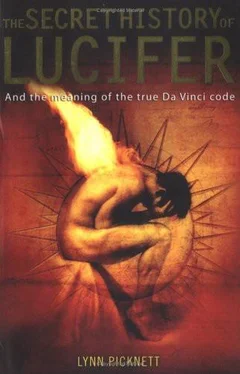However, Yahweh and his prophets did not suffer alone: other testosterone-fuelled deities had trouble with the Feminine. We have seen how the Greek Prometheus, like Lucifer, brought fire - symbolizing both civilization and intellectual inquiry - to humankind, against the will of Zeus, the all-powerful Olympian god. Empathizing with the sad fate of mankind, Prometheus acted out of compassion, to be rewarded by the eternal torture of having his liver eaten by his own totemic eagle, only to have it restored every night so the horrendous cycle could begin again. In Aeschlus' Prometheus Bound Prometheus mutters: `Mankind I helped, but I could not help myself', and reflects bitterly on `The mind of Zeus [that] knows no turning, and ever harsh the hand that newly grasps the sway.' However, he foresees a karmic punishment for Zeus at the hands of `the Fates triform and the unforgetting Furies' - the children of lo, the Moon-cow goddess (like Isis-Hathor in Egypt), who had also suffered at the hands of Zeus.
However, while Zeus the all-powerful will be brought low by the feminine he has oppressed, unfortunately - or so it seems - the converse is true where the almighty Biblical Yahweh is concerned. Although there remain strong undercurrents of the Feminine in modem Judaism, it is not usually recognized, certainly among the Orthodox.
In this light, the Biblical description of Lucifer, the fallen one, as a `shielding cherub' is particularly interesting. From the Hebrew K'rubh, which in turn is thought to derive from the Akkadian karibu - the cherubim were intermediaries between God and humanity, and not the morbidly obese infants with implausibly tiny wings so favoured by sentimental Victorians. In fact, a `graven image' existed in the Jerusalem Temple that graphically depicted two Cherubim engaged in a sexual embrace, representing a sacred mystery. Interestingly, there is not a hint of condemnation of this image in Jewish literature, even though the people fornicated orgiastically after seeing these statues carried before them in religious processions. As Patai notes of this custom,
`Since one of the two Cherubim was a female figure, we find that, in addition to the Canaanite goddess whose worship was condemned by the Hebrew prophets and Jewish sages [Asherah], the Temple of Jerusalem contained a replica of the feminine principle which was considered legitimate at all times .116
When Asherah was banished, the female cherubim lived on, unmolested - although, eventually, only with their femininity obscured and forgotten.
Much as the Israelites were loath to admit it, they carried a great deal of Egyptian thinking away with them when Moses led their flight from slavery in the land of the pyramids. Not only did Yahweh himself evince characteristics of the Egyptian destroyergod Set, but the Israelites also seem to have absorbed some of the feminine imagery of the dynastic age. Archaeologists excavating the palace of King Ahab of Israel (873-852 BCE) in Samaria discovered an ivory stele depicting two crouching female entities wearing distinctly Egyptian-style collars and clothes, and apparently holding the ceremonial lotus.
Raphael Patai suggests that they were really `female genii', similar to the equally female Shekhina, who survived incognito as the Christian `Holy Spirit', or the more blatantly feminine `Sophia', the Gnostics' embodiment of wisdom. Patai writes:
The Talmudic term `Shekhina' denotes a tangible - visible and audible - manifestation of God on earth - yet originally `the Shekhina concept stood for an independent, feminine divine entity prompted by her compassionate nature to argue with God in defense of man. She is thus, if not by character, then by function and position, a direct heir to such ancient Hebrew goddesses ... as Asherah ...;'
Although the Shekhina as such do not appear in the Bible, they are represented there metaphorically as Hokma or `Wisdom'. Intriguingly, Hokma may originate in one of the ancient titles of the Egyptian Isis, Heq-Maa, `Mother of Magical Knowledge', which dates back to the days of the powerful heq or tribal wise woman. Its derivative, the later Greek Hecate, or Wise Crone, was associated with the dark phase of the Moon and women's mysteries, including the secrets of life and death. The Neoplatonist scholar Porphyry (c. 234-305 CE) wrote in praise of her: `The moon is Hecate, the symbol of her varying phases ... Her power appears in three forms, having as symbol of the new moon the figure in the white robe and golden sandals, and torches lighted; the basket which she bears when she has mounted high is the symbol of the cultivation of crops which she made to grow up according to the increase of her light.'38 With historical inevitability, the much-loved Hecate was to
become one of the Christians' names for the Queen of Hell, while her threefold power was absorbed into Christianity by the medieval clergy who metamorphosed it into `The threefold power of Christ, namely in Heaven, in earth, and Hell."' But, as we will see, Hecate was especially singled out for anathema by the Church because of her alleged conspiracy with midwives to subvert the natural order by helping women, either by easing their pains or aborting unwanted foetuses - in other words, helping women to empower themselves 40 In a garbled version of this, in one old tradition, Satan's wife Lilas was supposed to hover about the birth-bed and kill newborns4'
In the Old Testament Book of Proverbs Hokma/Wisdom, the predecessor of Hecate, has a major role to play:
Does not wisdom call out? Does not understanding raise her voice? .. she takes her stand ... and cries aloud: To you, 0 men, I call out; I raise my voice to all mankind. You who are simple, gain prudence; You who are foolish, gain understanding. Listen, for I have worthy things to say; I open my lips to speak what is right. My mouth speaks what is true, For my lips detest wickedness ... They are faultless to those who have knowledge. Choose my instruction instead of silver, Knowledge rather than choice gold, For wisdom is more precious than rubies, And nothing you desire can compare with her.'42
The section of Proverbs known as the Proverbs of Solomon reinforces Wisdom's gender: `Wisdom reposes in the heart of the discerning/and even among fools she lets herself be known' 43 Proverbs also states that Wisdom, with her Aphroditean symbol of the dove, was God's first creation, and ever since as the Shekhina, in Patai's words, `she has been God's playmate' 44 Seemingly a Tinkerbell-like creature45 of darting intelligent light, the Shekhina was believed to possess a mind of her own, which she never hesitated to use in performing her function of influencing, even opposing, God. Clearly a feisty being capable of being tough with Yahweh had no very rosy future. As Patai notes:
From about 400 BCE to 1100 CE the God of Judaism was a lone and lofty father-figure, and whatever female divinity was allowed to exist in his shadow was either relegated to a lower plane, or her femininity was masked and reduced to a grammatical gender, as in the case of the Shekhina 46
Too like Christ for comfort
With the spread of Christianity, the old gods - both male and female - of the Mediterranean and Middle East were rapidly and hysterically demoted to the rank of demons, often because their legends were too similar to Jesus' story for comfort. The dying-andrising god Tammuz, whose consort was Ishtar-Mari, had reached Jerusalem via Babylon and before that, Sumer, as `Son of the Blood' or `only-begotten Son'. As a dying-and-rising god with a major cult centre in Jerusalem, Tammuz is believed by some to be one of the prototypes of Christ: his cradle was made from a grain basket, similar to Jesus' manger, for example 47 He was the sacrificial Lamb of God, Heavenly Shepherd, Man of Sorrow, and sometimes bore the name `Usirir', a variation of `Osiris', the hugely influential dying-and-ri sing god of ancient Egypt, who was dismembered by the evil Set, who in turn was arguably the prototype for Yahweh. Osiris, together with his consort Isis and son Horns, formed the great Egyptian Trinity of Father, Mother and Child, revealing a much more psychologically balanced psyche that the Church's apparently all-male `Father, Son and Holy Spirit' - although the latter was in fact the feminine Shekhina, or Sophia. (This is yet another example of a fact that theologians have long known and seminaries taught generations of priests, yet the average church-goer remains in ignorance of what would no doubt prove a comfort in a largely male-dominated organization.) The Egyptians sought balance above all things: the beneficent Isis was balanced by her dark aspect, the goddess Nepthys, while opposite to the `Good Shepherd' Osiris was Set, Yahweh's apparent prototype.
Читать дальше












